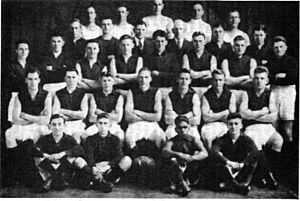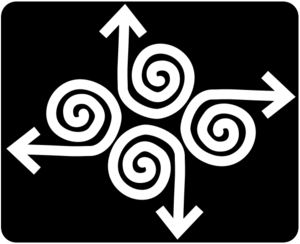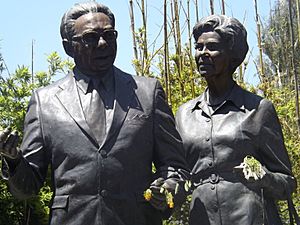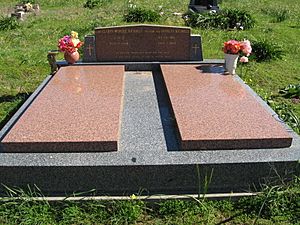Douglas Nicholls facts for kids
Quick facts for kids
Sir Douglas Nicholls
|
|
|---|---|
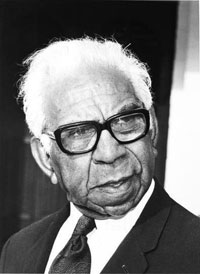 |
|
| 28th Governor of South Australia | |
| In office 1 December 1976 – 30 April 1977 |
|
| Monarch | Queen Elizabeth II |
| Preceded by | Sir Mark Oliphant |
| Succeeded by | Sir Keith Seaman |
| Personal details | |
| Born | 9 December 1906 Cummeragunja Reserve, New South Wales |
| Died | 4 June 1988 (aged 81) Mooroopna, Victoria |
| Nationality | Australian |
| Spouse | Gladys Nicholls |
| Profession | Pastor |
Sir Douglas Ralph Nicholls (9 December 1906 – 4 June 1988) was an amazing Aboriginal Australian leader. He belonged to the Yorta Yorta people. Sir Douglas was a professional athlete, a pastor for the Churches of Christ in Australia, and a strong voice for reconciliation between Aboriginal and non-Aboriginal Australians.
He made history as the first Aboriginal Australian to be knighted in 1972. This means he received a special honour from the Queen. He was also the first, and so far only, Indigenous Australian to become a Governor. He served as the Governor of South Australia from December 1976 to April 1977, but had to step down due to health issues.
Contents
Early Life and Challenges
Douglas Nicholls was born on 9 December 1906. His birthplace was the Cummeragunja Reserve in New South Wales. He was the youngest of five children.
Schooling at the mission only went up to Grade 3. When he was eight, his 16-year-old sister Hilda was sadly taken from their family by police. She was sent to a special home to be trained as a domestic servant. This experience deeply affected him.
At 13, Douglas worked on sheep stations. He was a tar boy and helped with general tasks. He lived with the shearers. One shearer challenged him to a fight, with the loser paying a week's wages. Douglas won the fight after six rounds!
A Sporting Hero
| Football career | |||
|---|---|---|---|
| Personal information | |||
| Original team | Tongala | ||
| Career highlights | |||
|
|||
Douglas Nicholls was a talented Australian rules football player. He started with the Tongala Football Club. In 1927, he joined the Northcote Football Club in the VFA. By 1929, he was a key player. He was known as a fast and energetic wingman. Even though he was only 157 cm (5'2") tall, he was considered one of the best wingmen in the VFA. He helped Northcote win the premiership in 1929.
In 1932, Nicholls moved to the VFL to play for the Fitzroy Football Club. In 1935, he became the first Aboriginal player chosen for the Victorian state team. He played four state games. He played six seasons for Fitzroy before returning to Northcote in 1938. Knee injuries forced him to retire in 1939. He later coached Northcote in 1947.
Sadly, Douglas faced racism on the field. Some players would taunt him or ignore him because of his skin colour. But he was very popular with fans. When he joined Fitzroy, a famous player named Haydn Bunton, Sr. befriended him. Bunton made sure Douglas felt welcome in the team.
Douglas was also a great sprinter. He won races in 1928. He later became the first chairman of the National Aboriginal Sports Foundation. To earn money when he wasn't playing football, he also boxed with Jimmy Sharman's Boxing Troupe.
During World War II, Douglas taught some American soldiers how to throw a boomerang. He also led Aboriginal football teams in games to raise money for the war effort.
Fighting for Aboriginal Rights
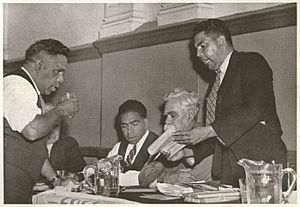
Douglas Nicholls' uncle, William Cooper, was a mentor to him. Cooper helped Douglas become the secretary of the Australian Aborigines' League. This group wanted Aboriginal affairs to be a federal matter. This meant changing the Constitution of Australia, which needed a public vote called a referendum.
In 1938, Douglas used his fame as an athlete to join the Day of Mourning protest in Sydney. This was on Australia Day, 26 January. Indigenous leaders from all over Australia demanded changes to the Constitution. They wanted new laws for Aboriginal education and care. They asked for "full citizen status and equality."
Douglas spoke passionately that day. He said: "The public does not realise what our people have suffered for 150 years. Aboriginal girls have been sent to Aboriginal Reserves and have not been given any opportunity to improve themselves. Their treatment has been disgusting. The white people have done nothing for us whatever... Now is our chance to have things altered. We must fight our very hardest in this cause."
It took 30 years for their goal to be achieved. In 1957, Douglas helped form the Federal Council for the Advancement of Aborigines and Torres Strait Islanders (FCAATSI). This group worked hard to change the Constitution. They collected petitions with thousands of signatures. Their goal was to remove the part of the Constitution that stopped the Federal Government from making laws for Aboriginal people. This movement became known as the "yes" campaign.
FCAATSI became the main group talking to the government. Pastor Doug met with Prime Ministers Robert Menzies and Harold Holt. His daughter, Pam, remembers him and his friend Alick Jackomos setting up a card table outside football games. They gave out papers and made speeches, asking people to sign petitions for the "yes" vote.
Douglas was also good at talking to the media. He used his skills as a preacher to deliver clear and powerful messages. He often said: "I think it’s a matter of democratic right. And we will form a part of the British commonwealth of nations and there should be no legislation setup to discriminate us."
The 1967 Australian referendum was a huge success! About 90% of Australians voted "yes" to change the Constitution. Douglas said this showed that Australians finally recognised Aboriginal people as part of the nation.
Community Work and Christian Ministry
Douglas Nicholls was a minister and social worker for Aboriginal people. After his mother passed away, he became more interested in Christianity. He was baptised in 1935. He became a lay preacher at the Gore Street Mission Centre in Fitzroy.
During World War II, Douglas was asked to work as a social worker in the Fitzroy Aboriginal community. He helped people with gambling problems, social issues, and those in trouble with the police. Many Indigenous people gathered around him. Soon, he became the pastor of Australia's first Aboriginal Church of Christ. He was officially ordained as a minister.
In 1957, Nicholls became a field officer for the Aboriginal Advancement League. He edited their magazine, Smoke Signals. He helped bring Aboriginal issues to the attention of the government and the public. He always asked for dignity and respect for Aboriginal people.
Douglas also helped set up hostels for Aboriginal children. He created holiday homes for Aboriginal people at Queenscliff. He was a founder and Victorian Secretary of FCAATSI. He also campaigned for an independent Aboriginal-run farming cooperative at Lake Tyers Mission.
Governor of South Australia
Sir Douglas Nicholls was appointed Governor of South Australia on 1 December 1976. He was chosen by Premier Don Dunstan. This was a very important moment. He was the first non-white person to be a governor of an Australian state. He is still the only Aboriginal person to have held this high office.
Sadly, on 25 January 1977, Douglas had a stroke. He had to go to the hospital. He had a history of high blood pressure. He was in the hospital for three weeks. During this time, another person, Walter Crocker, took over his duties.
Douglas only attended one more official event after his stroke. He hosted Queen Elizabeth II at Government House on 20 March. The Queen then gave him a second knighthood. Due to his poor health, he announced his retirement on 22 April. He officially left office on 30 April 1977. He was governor for only 150 days. This makes him the shortest-serving governor in South Australian history.
His Family
In December 1942, Douglas Nicholls married Gladys Nicholls. Gladys was the widow of his brother, Howard. Gladys already had three children. Douglas and Gladys were married for 39 years. They raised six children together: Bevan, Ralph, Beryl, Nora, Lilian, and Pamela. Lady Gladys Nicholls passed away in 1981.
Douglas Nicholls' great-grandson, Nathan Lovett-Murray, also became a professional Australian Rules Football player for Essendon.
Honours and Recognition
- 1957 – He was made a Member of the Order of the British Empire (MBE).
- 1962 – Named Victoria's Father of the Year. This was for his great leadership in youth and welfare work.
- 1968 – He was promoted to Officer of the Order of the British Empire (OBE).
- 1970 – Invited to meet Queen Elizabeth II during her visit to Australia.
- 1972 – Became the first Aboriginal person to be knighted. He and his wife Gladys went to London to receive this honour.
- 1973 – Named King of Moomba, a special honour in Melbourne.
- 1976 – Appointed the 28th Governor of South Australia.
- 1977 – Appointed a Knight Commander of the Royal Victorian Order (KCVO).
- 1991 – The Canberra suburb of Nicholls was named after him.
- 2001 – A new chapel at the Northern Community Church of Christ was named after him. This is the church where he was baptised.
- 2006 – A statue of Nicholls was approved for the Parliament Gardens in Victoria. It was opened in December 2007. It was the first statue of an Aboriginal person in Victoria.
- 2011 – Inducted into the Victorian Aboriginal Honour Roll.
- 2016 – The AFL named their "Indigenous round" after him. During this round, players wear special jerseys designed by Indigenous artists.
- 2018 – A federal election area (electoral division) was renamed Nicholls in honour of Sir Doug and Lady Nicholls.
- 2018 – A Google Doodle was created to celebrate his 112th birthday.
Death
Sir Douglas Nicholls passed away on 4 June 1988 in Mooroopna. He had a state funeral, which is a special public ceremony. He was buried in the cemetery at Cummeragunja.


